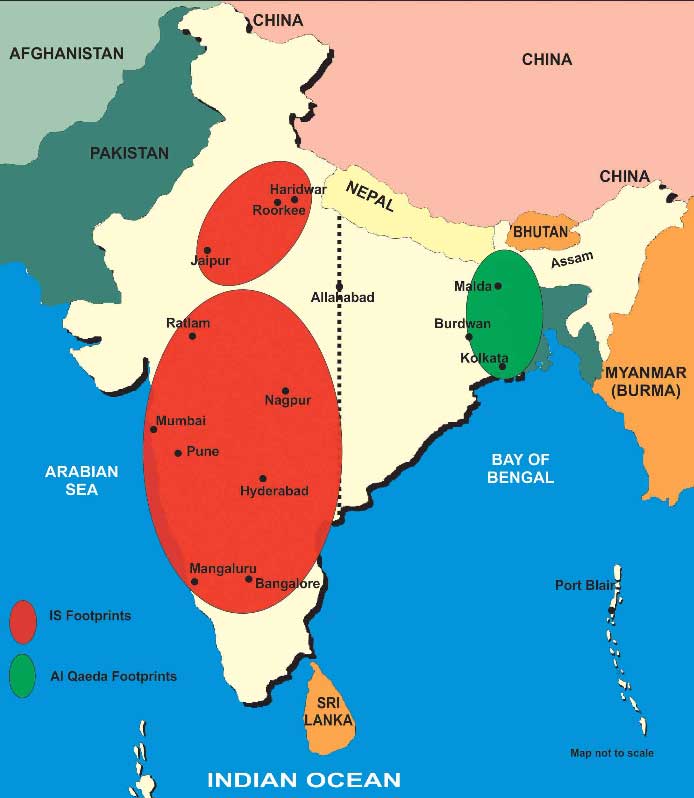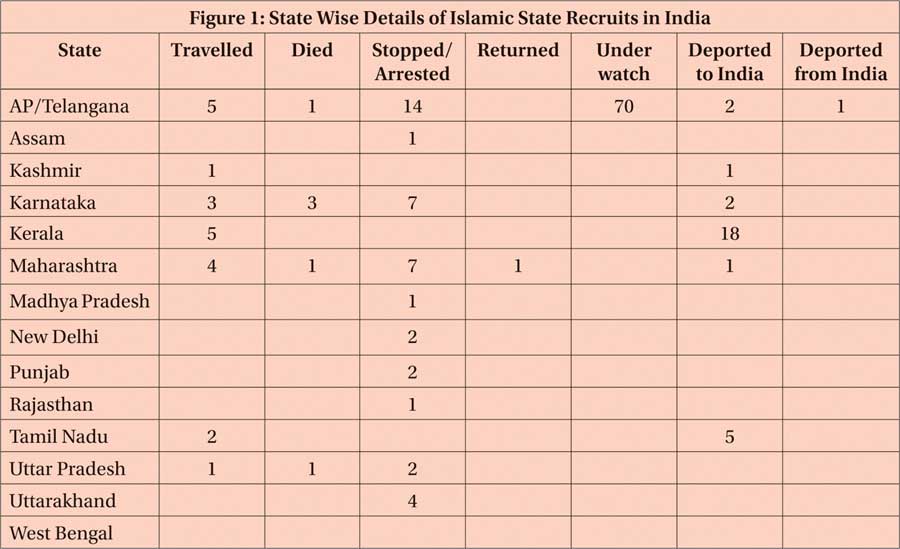Competition among fundamentalist groups could push each of them to outdo others who would evolve in a constant state of ‘one-upmanship’. There are already strong indications of such a threat emerging in India. Incidentally, the Al Qaeda’s first cell in the Indian subcontinent was recently uncovered in Sambhal. Given this discovery, the Islamic State’s growth in India will lead to competition among like-minded groups such as Al Qaeda in the Indian subcontinent, which would spur them on to unleash more violence in different parts of India. Constituted by a literate membership, driven by hardcore ideology, the Islamic State in India has essentially become a new brand of terrorism which is as yet unseen in the annals of political violence.
…the discovery of state-wise modules in 2016 by the National Investigation Agency, has lend credence to the theory that the Islamic State has already made inroads into India.
In September 2015, Western intelligence agencies stumbled across a 32-page Urdu document of the Islamic State in Pakistan. This document, which was obtained from a Pakistani citizen with linkages to the Pakistani Taliban, contained preparations to attack India through a final apocalyptic battle christened Ghazva-e-Hind.1 The prophesized Ghazva-e-Hind, when viewed along with Islamic State’s activities inside India, has certainly set the cat among the pigeons.
The Islamic State’s activities in India had remained largely muted till date. Even the political dispensation has attempted to quell the fears stating that Islamic State does not pose any danger to India only to retract it days later.2 However, the discovery of state-wise modules in 2016 by the National Investigation Agency, has lend credence to the theory that the Islamic State has already made inroads into India. Till 2015, scores have been prevented from going to Syria and Iraq, some hard core elements have been even been arrested in India. And yet this is the first time, local modules focused on terrorist activities have been discovered in India.
In one of the largest counter terrorist operations in the history of India, the National Investigation Agency swooped in and arrested around 20 Islamic State operatives and sympathisers across India in January and February this year. Six operatives namely, Mohammed Ahad, Mohammed Afzal, Syed Mujahid, Asif Ali, Suhail Mohammed, Najmul Huda from Karnataka, four operatives namely Mohammed Shareef, Mohammed Nafees, Abu Anas, Mohammed Obedullah from Telangana, four operatives namely Mudabbir Mushtaq Shaikh, Khan Muhammed Hussain, Imran Khan Pathan, Mohsin Ibrahim Sayeed from Maharashtra, two operatives Rizwan Ahmed Ali Nawazuddin, Mohammed Aleem from Uttar Pradesh, have been either arrested or detained with respect to their links to the Islamic State.
The UAE has deported a sizeable number of Indians suspected to have links with the Islamic State…
These arrests closely follow the arrest of four operatives of the Islamic State in the Indian state of Uttarakhand, a couple of days prior to this crackdown. The Special Cell of Delhi police arrested Akhlaq ur-Rahman, Mohammed Osama, Mohammed Azim Shah and Mehroz, who were alleged to have links with the Islamic State. This Islamic State module had planned to carry out attacks on some spiritual places, trains and malls in Delhi. These arrests follow the May 2015 arrest of the first known module in Ratlam which was loosely connected to the Islamic State.
These modules were handled by an Indian Islamic State operative in Syria known by his nom de guerre, Yusuf-al-Hindi, who is ostensibly Shafi Armar, the younger brother of Sultan Armar who died fighting for the Islamic State in Syria last year. The group’s Indian sympathisers have grown gradually since 2013, taking the total number persons travelled to Iraq and Syria to 27 (Figure 1).
The following data can be deciphered with respect to the Islamic State’s activities in India and outside India involving Indians:
The structure of the Islamic State modules which have been neutralised in India is more organised and hierachical…
- 27 Indians have so far joined the Islamic State, out of which six have been killed. One person has returned from the Islamic State voluntarily.
- Around 70 per cent of these recruits who have travelled are from South India.
- Around 41 persons with suspected links to Islamic State have been either arrested/prevented/stopped from going to Syria. A small percentage of Non-Resident Indians have also travelled to Syria directly.
- Of the 19 Indians who had planned to go to Syria in 2015, 16 were identified and stopped by the Telangana police alone.
- Nearly 30 persons suspectedto be IS sympathisers have been deported to India by various countries in recent times.
- Turkey has deported around 15 Indians. The UAE has deported a sizeable number of Indians suspected to have links with the Islamic State.
- Interestingly, a foreign national has been deported from India and two have been arrested attempting to cross over to Pakistan to join the Islamic State.
- The Government of India has blocked 60 websites promoting terrorism.
- Nearly 150 persons are currently under surveillance in India
- 70 sympathisers have been identified by the Telangana police alone and are under surveillance.
Developing Trends
The Islamic State is targeting highly educated youth with extremely good technical capabilities…
If we are to analyse the data related to the number of recruits who have been arrested, stopped, deported to India, interesting facets and trends emerge which indicate that the Islamic State is more organised and networked in 2016 compared to its earlier phase between 2013 and 2015.
Firstly, till 2015, most of the suspected Islamic State operatives arrested in India were planning to go Syria or Iraq, unlike the 2016 operatives whose primary objective was to conduct terror attacks inside India. These arrests and subsequent revelations indicate a clear departure from the Islamic State’s earlier recruitment pattern of moving recruits to Syria and Iraq. Earlier instances of recruitment for the Islamic State in India, pertains to flow of potential recruits out of India, who were either travelling to Syria or Iraq. On the contrary, the recent arrests point to the fact that the Islamic State is in the process of setting up modules within India, ostensibly to carry out terror attacks within India. These attempts by the Islamic State are a clear indication to deviate from its earlier attempts to move recruits from India to Syria or Iraq.
The structure of the Islamic State modules which have been neutralised in India is more organised and hierarchical. The organisation known as Janood-ul-Khalifa-e-Hind is headed by Amir Mudabbir Mushtaq Shaikh, followed by Naib Amir (Deputy), Mohamed Aleem, Najmul Huda as its military head and Mohammed Nafees Khan as the finance chief of the outfit. The organisational structure then percolates to the state level and city level arrangements with major presence in Mumbai, Uttar Pradesh, Karnataka, Uttarakhand and Tamil Nadu. Though, the superstructure appears highly hierarchical which would facilitate better control and governance, the bottom rung is more flexible, flat and virtually connected.
According to Europol, the EU contributed around 24 recruits between 2005 and 2007 but now the figure is in thousands…
Secondly, the Islamic State is targeting highly educated youth with extremely good technical capabilities. For instance, out of the total of 68 persons who have either travelled to Syria or arrested in India, at least 30 of them have a decent educational background. Among these literates, engineering and computer technology students make up a large chunk.
Thirdly, Islamic State activity is focussed mainly in South India in the states of Telangana, Andhra, Kerala, Karnataka and Tamil Nadu. Recruits from North India are far lesser compared to recruits from South India. Even Kashmir has contributed only one recruit so far. For instance, out of the total of 27 persons who travelled to Syria including the dead, 19 (70 per cent) are from the South India. However, with recent arrests, recruitment from other states such as Maharashtra, Uttarakhand have picked up indicating a growing trend.
Fourthly, community-related countermeasures appears to be more vocal in South India which strengthens the theory that South India is under a significant threat as most of counter measures from Islamic religious groups are concentrated in the four states of Tamil Nadu, Karnataka, Kerala and Andhra Pradesh. The rationale behind such an inference is that the Islamic religious groups who have been running a counter campaign against the Islamic State will be the first to know if a person(s) is radicalised and hence, any effort from their part has to be treated as high priority. For instance, a seminar by such groups against the Islamic State in a particular area, could indicate Islamic State related soft-core activity like sloganeering, posters and wall graffiti.
The recruitment pool is mainly from Telangana, Andhra, Karnataka, Kerala and Tamil Nadu. This certainly leads to the theory that the top recruiters of the Islamic State could possibly hail mostly from these Southern states or in other words, the recruitment network is managed by Southerners. Though this recruitment figure is only in double digits now, this could actually go up in future. For instance, according to Europol, the EU contributed around 24 recruits between 2005 and 2007 but now the figure is in thousands.3 The same scenario could play out in India if this is unchecked.








Of course a informative article about the growing terrorism but it also very terrifying for the common people who are want to live in peace. We should more aware about this rising problem.